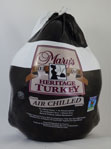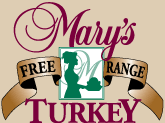Eating turkey on Thanksgiving is an American tradition, but today’s
supermarket turkeys barely resemble those enjoyed by early settlers.
Starting in the 1950s, turkey breeders, catering to consumer
preferences for white meat, started breeding turkeys to have big
breasts and small legs. These birds could grow to full size on less
feed and in half the time as the old-breed turkeys could—making turkey
cheaper than ever before. Farmers also started raising the birds
indoors and introduced artificial insemination, which made a turkey
dinner a year-round option (in nature, turkeys hatch in the spring and
reach “eating size” by late fall—not coincidentally, around
Thanksgiving).
While supermarket turkey can taste great if it’s carefully cooked,
something has been lost. Near extinction not so long ago—and still on
the “priority” list of the Livestock Conservancy—old-breed heritage
turkeys have had a renaissance in the past decade, with a handful of
farmers putting in the extra time, expense, and effort to raise these
colorfully plumed birds that, unlike modern commercial turkeys, can
fly, roam freely, and breed on their own. Could turning back the clock
bring back the flavor that’s disappeared from modern turkeys?
To find out, we bought heritage turkeys from seven farms scattered
across the United States. Breeds included Standard Bronze, American
Bronze, and Bourbon Red, as well as a bird whose label reads “parent
stock includes five different heritage breeds” and even an Eastern
wild turkey raised in semicaptivity. All were pastured, meaning they
were free to range outdoors and forage to supplement their feed.
The turkeys we unpacked were a far cry from the usual round, pale,
plump supermarket turkey. All featured startlingly long legs and
wings, a more angular breast and high keel bone, almost bluish-purple
dark meat (a sign of well-exercised birds), and traces of dark
pinfeathers in the skin around the tail. When we cooked one set
according to a standard method, we also found their flavor worlds
apart from ordinary turkey—far more rich and flavorful. We then
roasted all seven types of birds again according to Cook's
Illustratedrecipe customized to their unusual anatomy, and their
flavor was even more extraordinary.
Tasters raved about the “buttery,” “nutty-sweet,” “incredibly
satisfying, rich flavor” of the meat. The biggest revelation was the
white meat. Tasters found their favorite samples “amazing,” “unctuous
and silky,” with “sweet, succulent flavor,” and a texture that was
“perfectly tender” and “really moist.” So what was it about these
birds that made them, as one taster put it, “the turkey of my dreams”?
Seeing the Light
During carving, we’d noticed a distinct layer of fat under the skin on
the breast—more than what we’ve seen on a supermarket turkey. We know
that fat not only adds flavor but also helps keep meat of all kinds
moist during cooking. But, as Scott Beyer, extension poultry
specialist at Kansas State University, explained, the fat under turkey
skin is especially important. “If you peel off the skin, you strip
most of the fat right off with it,” he explained, noting that turkey
meat doesn’t become marbled with fat like beef. Our science editor
also pointed out that the moistness and lubrication from fat reduces
friction as you bite through the meat, making it more tender.
But how much of a difference was it, really? To find out, we sent
samples from each heritage turkey to a lab to analyze the fat in both
skin-on dark and skin-on white meat (uncooked). We also sent the lab a
Broad Breasted White from Butterball, the largest producer of turkey
products in the United States.
The results were convincing. The Butterball turkey had just 1.24
percent fat in its breast meat and skin, while breast-meat fat levels
for the heritage birds ranged from a low of 4.56 percent in the wild
turkey to a high of 10.63 percent in a Standard Bronze raised in
Kansas. (In the dark meat, heritage birds’ legs and thighs were
actually slightly leaner than supermarket turkeys’. This was not
surprising since they are more physically active, but overall the
heritage birds still had far more fat.) No wonder tasters found the
heritage turkeys so moist and tender.
So why would heritage turkey contain more fat? “Age,” said turkey
breeder Frank Reese Jr. of Good Shepherd Poultry Ranch in Lindsborg,
Kansas, who has been raising heritage turkeys since the 1950s and
sells breeding stock to other farms. (Reese is widely acknowledged as
the “dean” of heritage turkeys.) According to Reese, commercial
growers can raise a 20-pound turkey in 12 weeks, whereas “it would
take six months with a heritage bird. And if a turkey lives to be six
to seven months old, it has lived long enough to start putting on that
fat.”
A longer life has some other benefits, too. Beyer notes, “Inside [the
fat and meat] is the accumulation over months and months of minor
things from the feed and changes to the animal’s biochemistry;
proteins and lipids that aren’t there in younger turkey that may be
detectable as enhanced flavor.” According to Reese, their foraged food
would also contribute flavor.
Older birds also have much thicker skin, which helps shield the meat
and trap moisture, “like putting it in a Baggie,” Beyer said.
Meanwhile, most young, lean supermarket turkeys contain added flavor-
and moisture-enhancing liquid. Our Butterball’s label said it
“contains up to 8% of a solution of water, salt, spices, and natural
flavor.”
Finally, turkey breed may have played a part in our preferences. In
first and third place were Standard Bronze turkeys (both from Frank
Reese's breeding stock). The bird with a “mixed” parentage was
unremarkable, according to our tasters, and while flavorful, the wild
turkey meat was somewhat tough.
Paying for Flavor
There’s no denying that price is a big factor when considering
heritage turkeys. Supermarket turkeys averaged $1.72 per pound
nationwide last Thanksgiving, and promotional prices often dip well
below $1 per pound. Heritage turkeys can cost upwards of $10 per
pound; plus, required overnight or two-day shipping can nearly double
the price. Also, farms aren’t charging a per-pound price but rather a
flat price for a range of weights, such as 6 to 9 pounds, 7 to 14
pounds, and so on (similarly, you may be looking for a particular
weight but sometimes smaller or larger birds are the only choices
available). While we have a quibble with this pricing structure,
farmers aren’t getting rich; their rare, slow-growing, odd-size birds
are far more expensive to raise and process.
A heritage bird is a centerpiece for a special occasion, like beef
tenderloin or prime rib (which can cost $75 to $100 at the
supermarket). Our top pick was from a large family-owned farm in
California that also produces our winning brand of chicken. It has
everything we’re looking for in turkey, with rich, full flavor and
naturally moist meat. We’ll be happy to splurge on this and other
recommended heritage birds for the holidays—not just to save them from
extinction, but for the great taste they bring to our Thanksgiving
table.
Heritage Turkey Defined
In the 1500s, Spanish explorers took some wild North American turkeys
back to Europe and domesticated them. Then European colonists brought
these breeds—what we know now as heritage—back to North America in the
1600s. Heritage turkey (also called “Standard Bred” turkey) is not
just a matter of colorful feathers or romantic breed names like
Narragansett or Bourbon Red; the Livestock Conservancy and the
American Poultry Association agree that a heritage turkey is defined
by these three criteria:
1. Heritage
turkeys must have a long productive lifespan—five to seven years for
breeding hens, three to five years for breeding toms—and have a
genetic ability to withstand the environmental rigors of outdoor
production systems.
2. Heritage turkey
must have a slow to moderate rate of growth, reaching marketable
weight in about 28 weeks, giving the birds time to develop a strong
skeletal structure and healthy organs before building muscle mass.
Commercial turkeys grow to full size in only 12 to 14 weeks.
3. Unlike
commercial turkeys that must be artificially inseminated, heritage
birds are the result of naturally mating pairs of both grandparent and
parent stock.
METHODOLOGY:
We tasted six heritage turkeys, prepared using our recipe for Cook's
Illustrated Roast
Heritage Turkey. An independent laboratory measured fat and
protein in light and dark meat (including skin). Prices are what
we paid to mail-order a single turkey (shipping was extra). (Note:
To avoid shipping costs for our winning turkey, check out the
manufacturer's website for information on stores across the
country that carry the fresh birds during the holiday months.)










